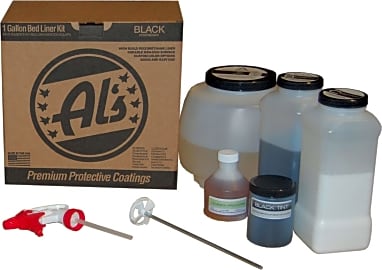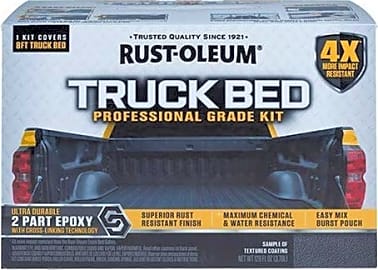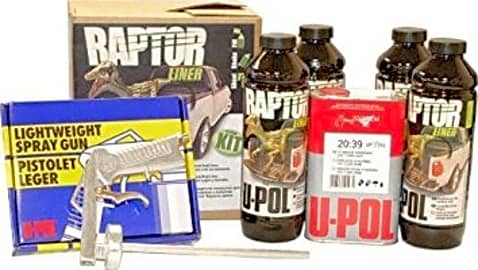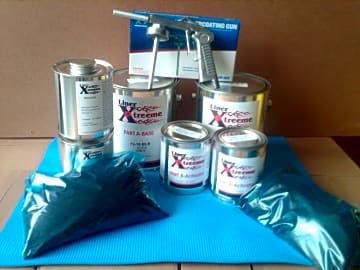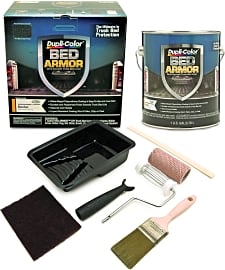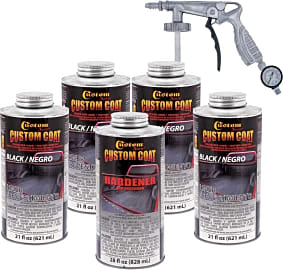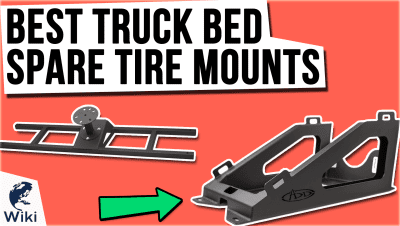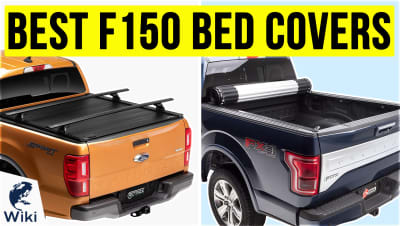The 7 Best Truck Bed Liner Kits

This wiki has been updated 35 times since it was first published in December of 2016. As a workhorse and a recreational vehicle, your truck bed gets a lot of use and abuse. So we have put together a list of the best liner kits available, so that you can haul just about anything without worrying about causing any damage. Most will also keep your load from shifting and making a noise, too. When users buy our independently chosen editorial picks, we may earn commissions to help fund the Wiki.
Editor's Notes
October 31, 2019:
Added Rust-Oleum 323529. As far as roll-on liners go, it is an appealing option because it builds a thick coat very quickly. This makes it less likely to split or chip off and require reapplication.
If you're applying a liner, it is crucially important to adequately prep the surface to ensure good adhesion - always start with a washed and dried surface. If the bed is painted, you'll need to scuff it up before priming. If there is old liner already there, it is best to sand it off before applying the new coat. It is good practice to cover up any surfaces you don't want painted with paper and painter's tape and then start first with the side walls. Roll and spray-on liners require multiple coats to gain the most benefit from the product.
A Brief History Of Truck Bed Liners
Today, bed liners are a big business, with a variety of companies cashing in on people who have their truck's best interests at heart.
Pickups were made to be treated roughly. Whether you were hauling building supplies, farm equipment, or that large throne made of human bones that we told you to leave in the forest where you found it, the bed of the pickup was designed to allow you to just toss your load in the back of the truck and go on about your day.
As consumers began to see their rides as fashion choices as much as utility vehicles, however, they placed a greater focus on protecting the body from dings and scratches. The first liner modifications came along in the 1950s, when people began to install planks of wood in the bottom of their beds. This provided a fair amount of protection while also giving the truck a more rustic look.
That was about the extent of liner innovation for the next 20 years or so, as individual owners were responsible for making their own modifications, and wood was about the only material available that was suitable for protection.
There were a few problems with using lumber, however. First off, wood is a porous material, so it offered little protection against spills and leaks. Plus, if something did end up leaking — or if the truck was left out in the rain — the wood would eventually rot. You also had to worry about bugs chomping on your liner, and there's probably nothing more demoralizing than finding out that your vehicle has termites.
In 1976, however, an inventor named Robert H. Lambitz patented a new cargo box liner, made of plastic, that you could simply drop in to the bed of the truck. Lambitz used a technique called thermoforming, which allowed engineers to shape plastic or acrylic to a specific mold — like a truck bed, for instance.
However, another innovation was just over the horizon: spray-on liners.
In 1983, a South African named Morgan Evans developed a type of urethane that could sprayed onto rail cars and delivery vehicles, protecting them from wear and tear. A few years later, one of his countrymen would take this technology overseas, and the U.S. was introduced to spray-on bed liners for personal trucks.
Today, bed liners are a big business, with a variety of companies cashing in on people who have their truck's best interests at heart. That said, having one is a great way to keep your ride looking sharp — not to mention boost its resale value.
Why You Need A Truck Bed Liner
Buying a new truck is expensive (even if it's an old new truck), so you can be forgiven if you want to cut costs by skipping the bed liner. However, before you do, you should consider all the benefits you'd be missing out on as a result.
The biggest and most obvious is that it will spare your bed from damage when you're hauling stuff around. That's especially important if you're a contractor, farmer, or anyone who, you know, uses a truck for truck purposes.
If you have a liner between your bed and the sun, however, your truck will still look pristine and new underneath.
It's not just dings and scrapes that you have to worry about, either. UV rays can damage your vehicle, causing the paint to fade and crack. If you have a liner between your bed and the sun, however, your truck will still look pristine and new underneath.
Of course, your paint is just the top layer of the truck — and the bottom layer is made of metal that can rust and corrode over time. Your paint is designed to prevent that, but if it gets scraped off, there's nothing stopping the elements from doing a number on your jalopy.
If the things you haul around are actually valuable in and of themselves, having a liner will minimize the risk that they'll get damaged, thanks to its non-slip properties. Everything will stay right where you put it — and you won't have to worry about opening the tail gate to find that your antique furniture is now antique firewood.
Beyond all the practical reasons, many people think it just makes the truck look better. This can make your ride stand out, as well as put more cash in your pocket when it's time to sell it, making a bed liner an investment that can pay off over time.
Ultimately, though, the most important reason might be because it makes your truck bed more comfortable to sleep in, which is something you'll need when your spouse finds out exactly how much you spent on your truck.
Other Ways To Spare Your Pickup Some Abuse
While installing a bed liner is a smart first step in making sure that your truck stays in mint condition, it has one major drawback: it can only protect the bed. There's lots more truck out there that you also need to protect.
If you live in a dry, arid climate, try to park your truck in the shade.
Being a safe and conscientious driver is paramount, of course, so pay attention while you're behind the wheel. (You can text while driving, but only if you want to meet your friendly neighborhood paramedics.) Also, many small accidents are caused by hazards that were hard to see, so investing in a backup camera is probably worthwhile.
If you live in a dry, arid climate, try to park your truck in the shade. Also, use a windshield screen when you're parked to prevent the dash from cracking and fading.
On the other hand, if you have to deal with frigid temperatures for part of the year, wash your undercarriage regularly after you've been driving on salted roads. Try to avoid driving through puddles, and make sure to wipe your feet before climbing inside, because all the slush you track into the cab can rot your floorboards.
Keeping your truck in top shape isn't terribly difficult — it just takes a little bit of awareness. The rewards are well worth it, however, especially when your truck becomes the most envied ride on the block.


